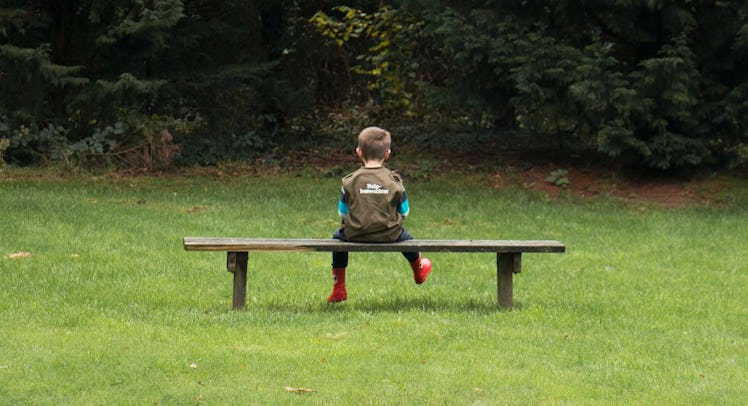6 Ways To Get Young Kids To Understand Their Feelings And Communicate Better
Amp up that emotional IQ.

There’s a principle in psychology that the mere act of acknowledging a person’s feelings can help bring about powerful relief. This is especially true of kids. But parents often screw the pooch on this one. “So often our instinct is to try to correct or fix a feeling a child is expressing,” says Julie King co-author of How to Talk So Little Kids Will Listen, the follow-up to the parenting staple How To Talk So Kids Will Listen And Listen So Kids Will Talk. “But what could be most helpful is to put the feeling into words for them.”
This is easier said than done, especially when Junior is throwing an adult-sized tantrum. King offers up these 6 tactics that will help you (and your kids) understand the underlying emotion behind a freakout — and put you both on the peak hour train to Pleasantville. And guess what? It’s all quiet cars.
Use Your Words
The first step in acknowledging any problem, from a bath-time breakdown to a mid-mall meltdown, is to build up your child’s vocabulary of “feeling” words. So, when your kid is Hulking out because you put their juice in the wrong colored cup, the first thing you need to do is grit your teeth and resist the urge of contradicting your child (even if your brain is screaming at them to just drink the f—ing juice!).
Then, think about the emotion they’re feeling, name it, and put it in a sentence. Frustrated. You’re feeling frustrated because you don’t have your blue cup. Is that right? You’re frustrated that you can’t turn on the water?” King notes that when your child can say, ‘I am frustrated!’ instead of ratcheting up to a tantrum, you know you’re on the right track.
Acknowledge Feelings With Writing Or Art
King also says that if kids can’t read, seeing their feelings and desires written out can be very powerful. She points out that “when a child takes a tantrum over something that you don’t have — say, macaroni and cheese — what they need to hear is, ‘Let’s write it down on our shopping list so we can get it.’” Why? Because writing it down shows a child that you’re really taking this seriously.
How To Talk So Little Kids Will Listen cites an example of a child who wanted a chocolate chip cookie bad and it was obvious things were about to get scream-y. But a clever dad demonstrated writing the word “cookies” on a shopping list and drew a circle to symbolize it. The child chimed in, added dots for chocolate chips, and was content to carry the drawing around. Defcon 5 averted. Just note that scribbling a gift box definitely won’t defuse your spouse’s rage if you forget an anniversary.
Give In Fantasy What You Can’t In Reality
For those times when your kid is about to lose it because they want a pony, velociraptor, or something else that’s impossible to provide, King says to give it to them. In a fantasy world. “Your first impulse is usually to explain why she cannot, or should not, or must not have her heart’s desire,” says King. “But that’s the rational approach.” Pretending is a harmless way of understanding emotions. And she encourages parents to follow along, i.e. Oh I wish we could have a velociraptor, too. 6 or 7 maybe! What colors would they be?’ “I’m just repeating what she wants and yet that alone can be incredibly powerful,” says King. “The technique helps a child calm down, solve a problem, or learn to wait.” Plus, you get to dream about dinosaur ownership. Win-win!
Give Them The (Near) Silent Treatment
Sometimes a child just wants to get something off their chest and a full-fledged parental response isn’t even necessary. Simple grunts signal to your partner that you don’t care about their day. But King says that, when talking with a child, a simple “Oh,” “Oh my!” “Ugh” or “Huh” signals that you’re really listening, that your feeling the emotional tone of what they’re saying. “The important thing is just to give them your attention and not jump in immediately with parental advice, questions or quick fixes.”
Have Some Fun With It
Like many adults, kids don’t want to be told what to do. So the big idea in getting them to do what you want is to make them feel as though they’re making the choices. “But that conflicts with the reality that we need to get kids to do a whole lot of things,” says King. So how do you do both? By getting your fun on. Instead of telling the child to put on her shoes 7 or 8 times, she suggests breaking out a funny voice and having the shoe say, ‘Oh, I feel cold and empty. Won’t somebody put a nice warm foot in me?’ Such tactics subtly inform them more about feelings – and gives you a chance to perfect what a sneaker would sound like.
This article was originally published on